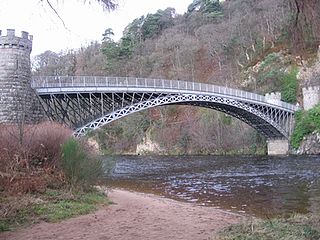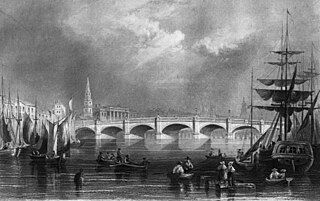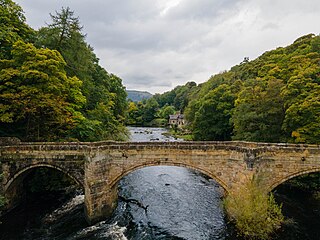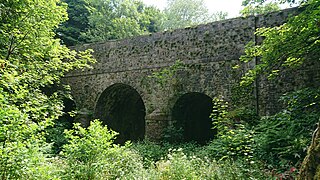
The Caledonian Canal connects the Scottish east coast at Inverness with the west coast at Corpach near Fort William in Scotland. The canal was constructed in the early nineteenth century by Scottish engineer Thomas Telford.

The Galton Bridge is a cast-iron bridge in Smethwick, near Birmingham, in the West Midlands of England. Opened in 1829 as a road bridge, the structure has been pedestrianised since the 1970s. It was built by Thomas Telford to carry a road across the new main line of the Birmingham Canal, which was built in a deep cutting. The bridge is 70 feet above the canal, making it reputedly the highest single-span arch bridge in the world when it was built, 26 feet wide, and 150 feet long. The iron components were fabricated at the nearby Horseley Ironworks and assembled atop the masonry abutments. The design includes decorative lamp-posts and X-shaped bracing in the spandrels.

Castle Stalker is a four-storey tower house or keep in the Scottish county of Argyll. It is set on a tidal islet on Loch Laich, an inlet off Loch Linnhe. It is about 1+1⁄2 miles north-east of Port Appin and is visible from the A828 road about midway between Oban and Glen Coe. The islet is accessible with difficulty from the shore at low tide. The name "Stalker" comes from the Gaelic Stalcaire, meaning "hunter" or "falconer". The island castle is one of the best preserved medieval tower houses to survive in western Scotland and is a Category A listed building. It stands in the Lynn of Lorn National Scenic Area.

Mingary Castle, also known as Mingarry Castle, is a castle situated one mile southeast of the small village of Kilchoan in Lochaber, Scotland. Nestled on ridge of rock overlooking the sea, it was considered a strategically important site in terms of communication with overseas areas and as an entranceway to the Sound of Mull. Mingary is roughly hexagonal in shape with nine-foot-thick walls, thicker on the seaward side. The remains of the castle are protected as a category A listed building.

Navigable aqueducts are bridge structures that carry navigable waterway canals over other rivers, valleys, railways or roads. They are primarily distinguished by their size, carrying a larger cross-section of water than most water-supply aqueducts. Roman aqueducts were used to transport water and were created in Ancient Rome. The 662-metre (2,172 ft) long steel Briare aqueduct carrying the Canal latéral à la Loire over the River Loire was built in 1896. It was ranked as the longest navigable aqueduct in the world for more than a century, until the Magdeburg Water Bridge in Germany took the title in the early 21st century.

Craigellachie Bridge is a cast iron arch bridge across the River Spey at Craigellachie, near to the village of Aberlour in Moray, Scotland. It was designed by the renowned civil engineer Thomas Telford and built from 1812 to 1814. It is a Category A listed structure.

The Clachan Bridge is a simple, single-arched, hump-backed, masonry bridge spanning the Clachan Sound, 13 kilometres (8 mi) southwest of Oban in Argyll, Scotland. It links the west coast of the Scottish mainland to the island of Seil.

Edzell Castle is a ruined 16th-century castle, with an early-17th-century walled garden. It is located close to Edzell, and is around 5 miles (8 km) north of Brechin, in Angus, Scotland. Edzell Castle was begun around 1520 by David Lindsay, 9th Earl of Crawford, and expanded by his son, Sir David Lindsay, Lord Edzell, who also laid out the garden in 1604. The castle saw little military action, and was, in its design, construction and use, more of a country house than a defensive structure. It was briefly occupied by English troops during Oliver Cromwell's invasion of Scotland in 1651. In 1715 it was sold by the Lindsay family, and eventually came into the ownership of the Earl of Dalhousie. It was given into state care in the 1930s, and is now a visitor attraction run by Historic Environment Scotland. The castle consists of the original tower house and building ranges around a courtyard. The adjacent Renaissance walled garden, incorporating intricate relief carvings, is unique in Scotland. It was replanted in the 1930s, and is considered to have links to esoteric traditions, including Rosicrucianism and Freemasonry.

Dunans Castle is an historic structure located in Glendaruel, on the Cowal peninsula, Argyll and Bute, Scotland. The property is owned by Charles and Sadie Dixon-Spain. A property at Dounens was shown on maps in 1590; Dunans House was elaborated into its present mock castle form in 1864. Once part of a much larger estate the property presently includes 16 acres (65,000 m2) of ground and in 2001 was ruined by fire.
The Bridge of Awe was a triple-spanned arch bridge near Taynuilt in Argyll, Scotland.

Achanduin Castle,, is a castle, now in ruins, located about 5.0 kilometres (3.1 mi) west of Achnacroish on the north-western coastline of the island of Lismore, in Argyll and Bute, Scotland. The castle overlooks Loch Linnhe and Bernera Island. The ruins are thought to date back to the thirteenth century. Achanduin Castle had long been thought to have been built by the Bishop of Argyll, though recent research has proved this to be unlikely. The castle was likely built by the MacDougalls around 1290 who held it throughout the fourteenth century. The castle was also thought to have been held by the Bishops of Argyll until the mid sixteenth century. It is a scheduled ancient monument.

The Glasgow Bridge spans the River Clyde in Glasgow linking the city centre to Laurieston, Tradeston and Gorbals. Formerly known as Broomielaw Bridge, it is at the bottom of Jamaica Street near Central Station, and is colloquially known as the Jamaica Bridge.

Craignish Castle is located on the Craignish peninsula in Argyll, western Scotland and is a category B listed building. The present castle includes a 16th-century tower house, the seat of the Campbell family of Craignish and Jura. In the 19th century it was sold to the Trench-Gascoigne family of Parlington Hall, Yorkshire, who built a large extension to the tower. In the later 20th century the house was restored and parts of the 19th-century extension were demolished. The result of these extensions and styles from various centuries have made the castle a Scottish baronial masterpiece. It has previously been known as Loch Beag.

Neidpath Viaduct, occasionally known as the Queen's Bridge, consists of eight stone skew arches and was built to carry the Symington to Peebles branch line of the Caledonian Railway over the River Tweed to the south-west of Neidpath Castle. Now closed to rail traffic the bridge is used as a footpath.

The Yair Bridge or Fairnilee Bridge is a bridge across the River Tweed at Yair, near Galashiels in the Scottish Borders.

Pont Cysyllte, also known as Cysylltau Bridge or Bont Bridge, is a 17th-century road bridge crossing the River Dee near the village of Trevor, Wrexham County Borough, Wales. It lies 200 m west of Thomas Telford's Pontcysyllte Aqueduct and, carrying the B5434 road, is the main connection between Trevor and nearby Froncysyllte.

Aray Bridge, also known as Inveraray Bridge, is a stone two-arch public road bridge on the Inveraray Castle estate near Inveraray in Argyll and Bute, Scotland, carrying the A83 road over the mouth of the River Aray where it flows into Loch Fyne.

Craigmin Bridge is an eighteenth century bridge within the grounds of Letterfourie House, in Moray, Scotland. Spanning the Burn of Letterfourie, it once formed part of the main approach road to the house. Probably built by Robert Adam, who designed the house, it is a Category A listed building, and is currently on the Buildings at Risk Register for Scotland.

The Old Spey Bridge is a footbridge on the outskirts of Fochabers in Moray, Scotland, which formerly carried the main road between Inverness and Aberdeen over the River Spey. Originally built between 1801 and 1806 by George Burn, it was partially destroyed in the Muckle Spate of 1829, with two of its arches being washed away. Archibald Simpson repaired the bridge in 1831 with a single timber span, which was reconstructed in cast iron in 1853. The bridge is designated a Category A listed building.

Kirkdale Bridge is a bridge over the Kirkdale Burn in the parish of Kirkmabreck, between Gatehouse of Fleet and Creetown in Dumfries and Galloway, Scotland. It was built for Sir Samuel Hannay, based on designs drawn up by Robert Adam, but the execution was much simpler than Adam had originally envisaged, probably to reduce the construction costs.




















